Despite macroeconomic challenges this year, investment in cross-border payments startups has continued, in particular with B2B payments, while crypto continues to pick up steam in the US. In this state of the industry report for 2023, we explore which types of cross-border payments startups have seen the most funding in 2023.
After the downturn that began in 2022, 2023 has once again provided a tougher investment climate than in previous years, with less venture capital available for projects. Macroeconomic challenges, namely high inflation, the Silicon Valley Bank collapse and ongoing conflicts, have all contributed to an increasingly challenging operating environment, which has led to a greater focus on profitability among investors.
Despite this, cross-border payments startups have continued to see funding in 2023 as investors capitalise on the demand for faster, less costly payments worldwide. Companies at all levels of development have seen funding, albeit at potentially lower levels than in previous years.
As part of this, there have been a small number of high-value late-stage fundraises in the space in 2023, although on arguably more sober terms. Stripe, for example, signed an agreement for a Series I round worth more than $6.5bn, although saw its valuation halve in the process.
However, there are also trends in terms of the areas that are receiving the most funding. B2B has taken the lion’s share of investment this year, although segments including financial infrastructure and payment processors have also been prioritised.
This report delves into the data on funding rounds announced in 2023 to explore the main trends across startup investment in 2023, including both the regions and focuses drawing the most interest.
2023 trends in cross-border payments startups: Methodology
This report uses data from Crunchbase to highlight companies in the mobile payments and payments sectors that had their latest funding round in 2023, between 1 January and 22 November. Companies were removed from the list if they did not have a cross-border payments offering as part of their services, or if they were raising post-IPO funds.
This left a definitive dataset of 176 cross-border payments companies that have seen their most recent funding round in 2023.
We analysed this data to determine key details about each company. This included each company’s main sector focus and location, as well as whether they use cryptocurrency or blockchain technology as part of their offering. We also looked at the stage of funding each company was raising at, and which investors were most prolific in the sector this year.
Which cross-border payments sectors have attracted the most funding in 2023?
Among the 176 companies analysed, B2B cross-border payments companies were the most prevalent, accounting for 32% of assessed businesses. This was followed by payment processors (21%) – which here refers to companies that orchestrate multiple payment types for merchants, as well as those that process payments directly – and payments infrastructure providers (15%), which provide networks and other financial infrastructure that is used by companies to complete payments.
B2B payments’ dominance reflects the relative lack of maturity in this space, compared to remittances. B2B payments is currently a fragmented market, with no single player having more than 1% share of the non-bank space. However, it also has strong growth potential. FXC’s data shows that it is set to grow substantially over the next few years, climbing at a CAGR of 5.9% between 2024 and 2032.
This creates potential for new players in the space, which may be why this area has been favoured by investors.

What stage are companies attracting funding at?
Over the course of the year, the companies attracting the most funding were those raising at the Seed and Pre-Seed stages. While 10% of the most recent rounds for cross-border payment are listed under ‘Series Unknown’, around 31% of them were Seed funding, while 18% were Pre-Seed funding rounds. No other funding round type gained 10% plus across our tracking.
The dominance of early-stage funding is unsurprising, as not all companies succeed beyond this point, however it does show positive signs for the future of the industry, indicating that a more challenging VC environment has not prevented companies in this space from attracting investment.
However, the split of funding stages within different segments of the industry suggest that certain types of companies are attracting more early-stage investment than others – either due to there being more companies of this type at early stages, or because early-stage investors are favouring them.
While 37% of payments infrastructure players, 41% of payments processors and 44% of neobanks saw either Pre-Seed or Seed investment, 56% of global payroll, 54% of B2B payments and 64% of money transfers investment were at these stages.
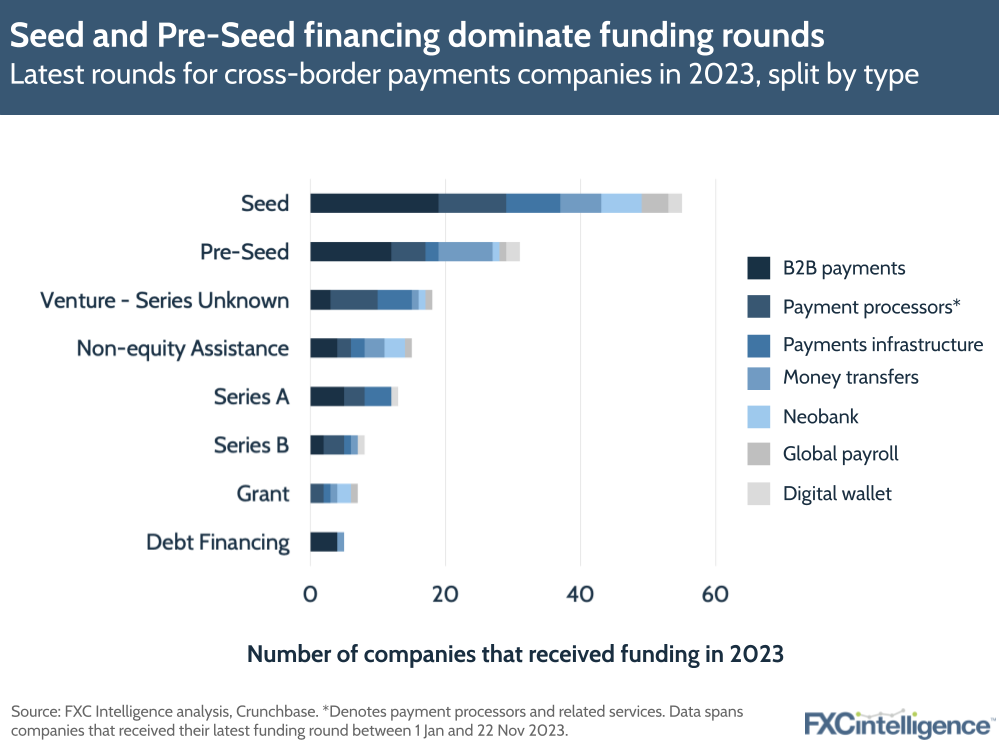
Funding for crypto-enabled payments startups
Notably, while cryptocurrencies such as Bitcoin have seen receding interest in the cross-border payments space, there has been slow but growing use of blockchain and other crypto technologies such as stablecoins within the space. Here the technology is being used in a variety of ways, often to facilitate payment solutions without being widely discussed in the company’s marketing.
While the majority of the companies in the dataset do not make use of crypto, 26% analysed do use the technology in some form.
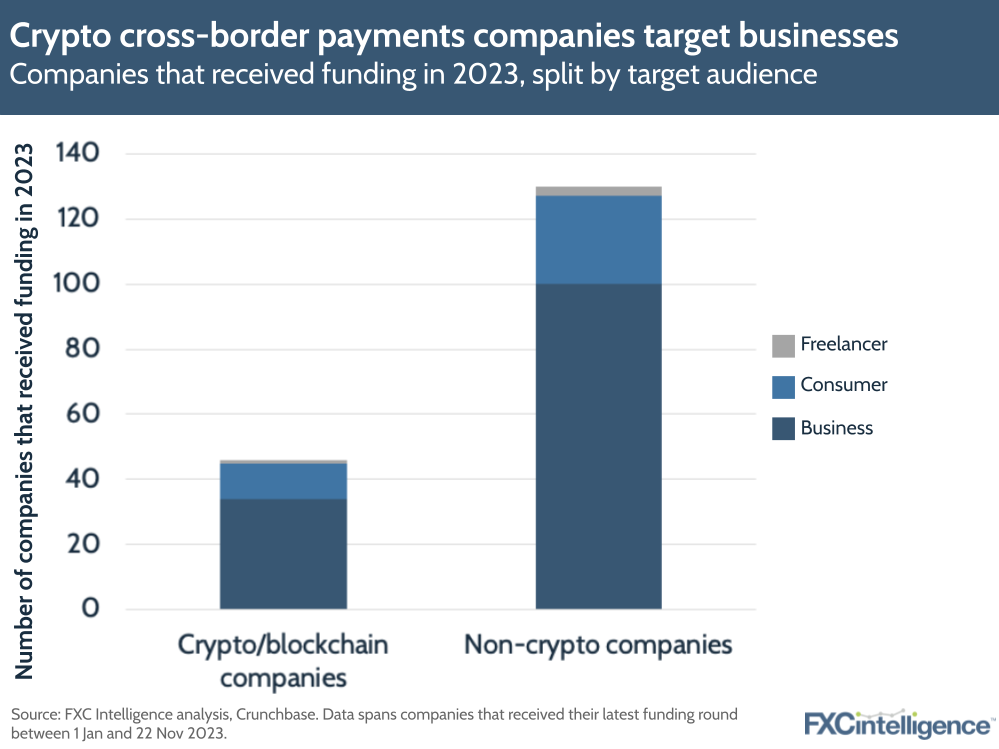
While companies with crypto or blockchain capabilities may be in the minority, it is notable that companies from almost every one of our prescribed categories have some such capability, with the exception of neobanks. However, crypto was more present in some categories than others. 50% of digital wallets on the list had a crypto capability, versus 32% of money transfer companies, 30% of payment processors and 21% of B2B payments companies.
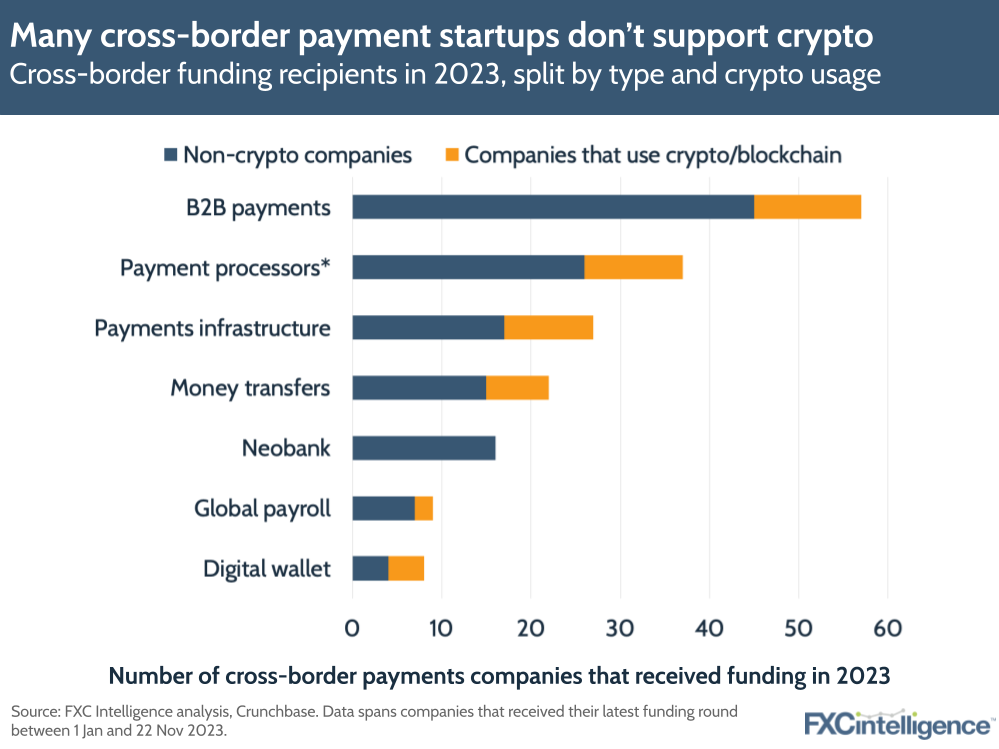
Interestingly, while 53% of companies using crypto were founded in 2020 or later, this was fewer than non-crypto companies, at 57%. This is also reflected among companies founded in 2010 or later, with 85% of cross-border payment companies using crypto that received investment this year having been founded after 2009, compared to 98% of cross-border payment companies that do not use crypto. This is particularly significant given that earlier this year we found that cross-border payment companies using crypto were more likely to receive funding than those that weren’t. We also found that crypto-based companies were disproportionately based in the US, which may speak to a regional rather than global focus on the technology.
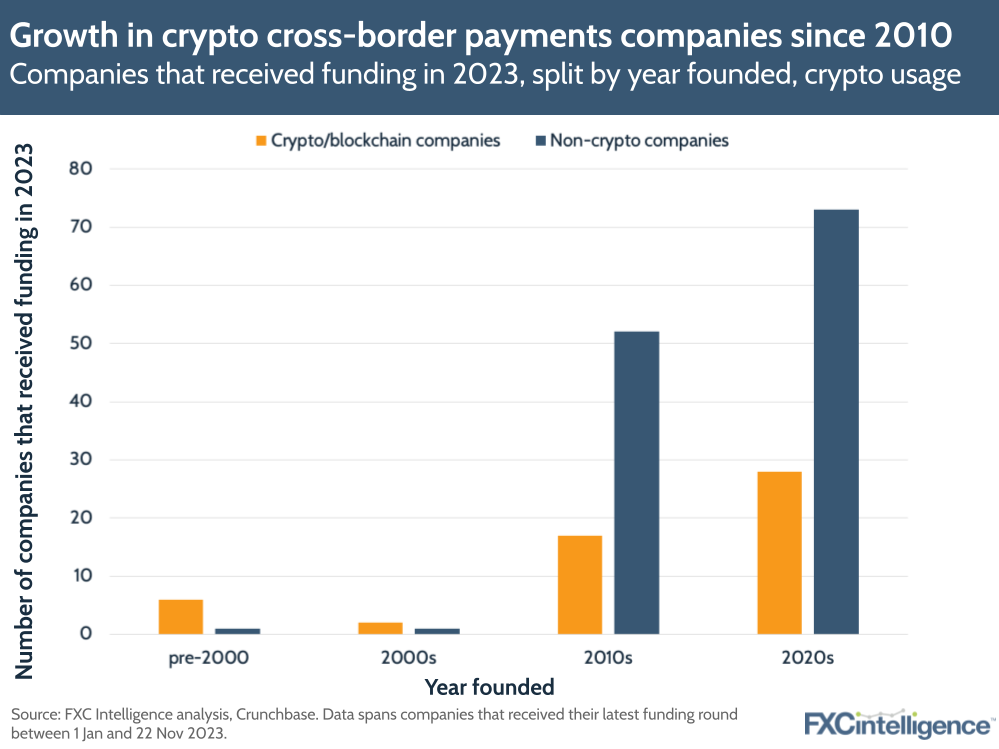
The potential of crypto in cross-border payments has been discussed regularly, with some suggesting that it could provide faster settlement solutions than other payments networks. However, the dominance of non-crypto companies among newer players suggests that it is not destined to take centre stage in the space.
What countries are cross-border payments startups receiving funding in?
Looking at the headquarters of cross-border payments startups who have received funding this year indicates that investors are looking globally for companies to take stakes in.
Not all companies are headquartered where they were founded – it is not unusual to shift headquarters to the US from many countries, for example – however at early stages HQs do provide a strong sense of the regions that investors are interested in.
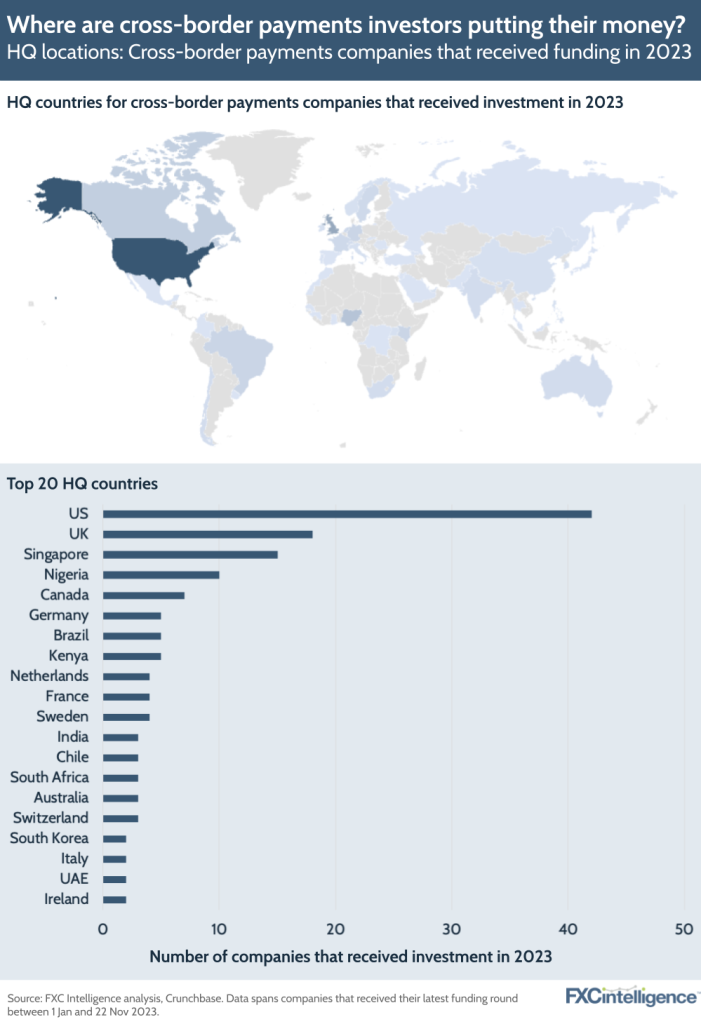
Across the dataset, 50 countries were represented as headquarters locations for the startups analysed. Out of these, the US saw the highest number of companies receiving some form of investment – around 24% of the companies total – followed by the UK, Singapore and Nigeria.
These represent the major hubs of their respective regions for cross-border payments. The US is a long-established major for payments, and the biggest source of outbound consumer money transfers globally, while the UK has long been a major hub for B2B payments in particular. Meanwhile, Singapore is critical to Asia and in particular the fast-growing Southeast Asia region, while Nigeria has emerged over the last decade as a key and fast-growing space of payments in Africa.
Moving further down the list, European countries appear regularly, with Sweden, France and the Netherlands each having four startups receiving investments, as well as countries in LatAm, the Middle East, Africa and Southeast Asia – several of which see substantial demand for remittances and B2B cross-border payments.
Below, we’ve looked at some of the biggest hubs for cross-border payments startup investment funding in more detail.
US
One of the leading countries in the world for foreign direct investment, the US is a hub for cross-border payment investments, with investors primarily funding B2B payments, money transfers and infrastructure companies in the region.
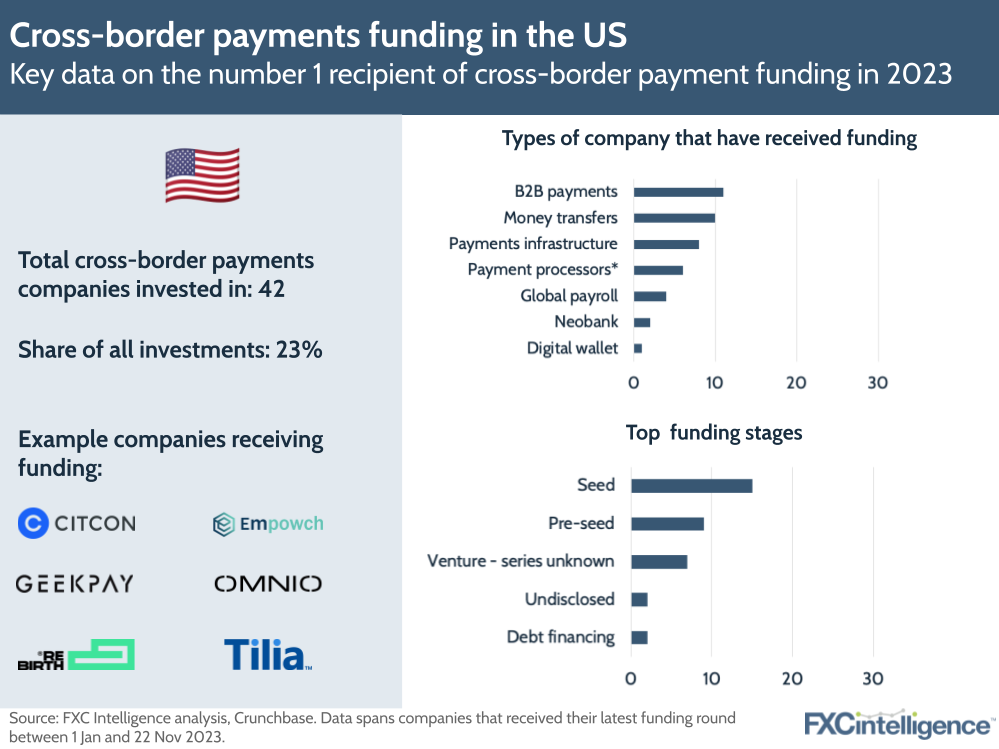
UK
The UK continues to produce a high number of B2B payments companies, with 39% of UK companies from the list being in this space. Fintechs in the region are also focused on money transfers and payments processing. The UK has seen some investor concerns over its exit from the EU, but continues to house some of the fastest-growing fintechs.
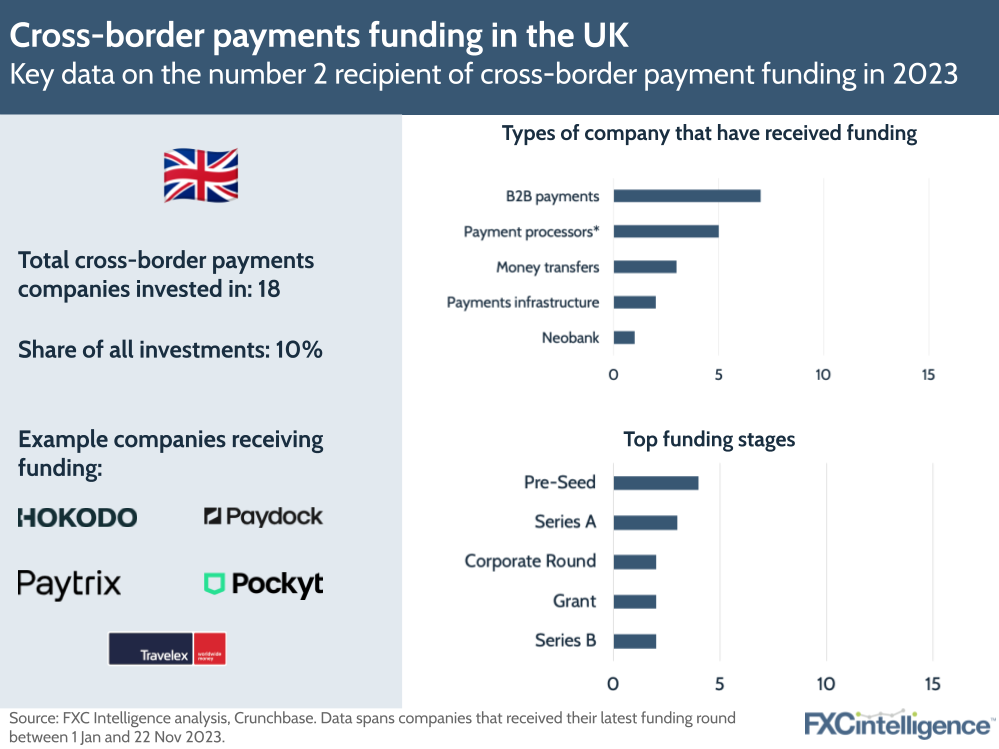
Singapore
Singapore has been a hotbed of activity in the cross-border payments space, having linked up its instant payment system with that of Malaysia, Indonesia and Thailand in the last few years. Investments were dominated by B2B but digital wallets were also present, highlighting a drive for businesses in the country to foster financial inclusion in Southeast Asia.
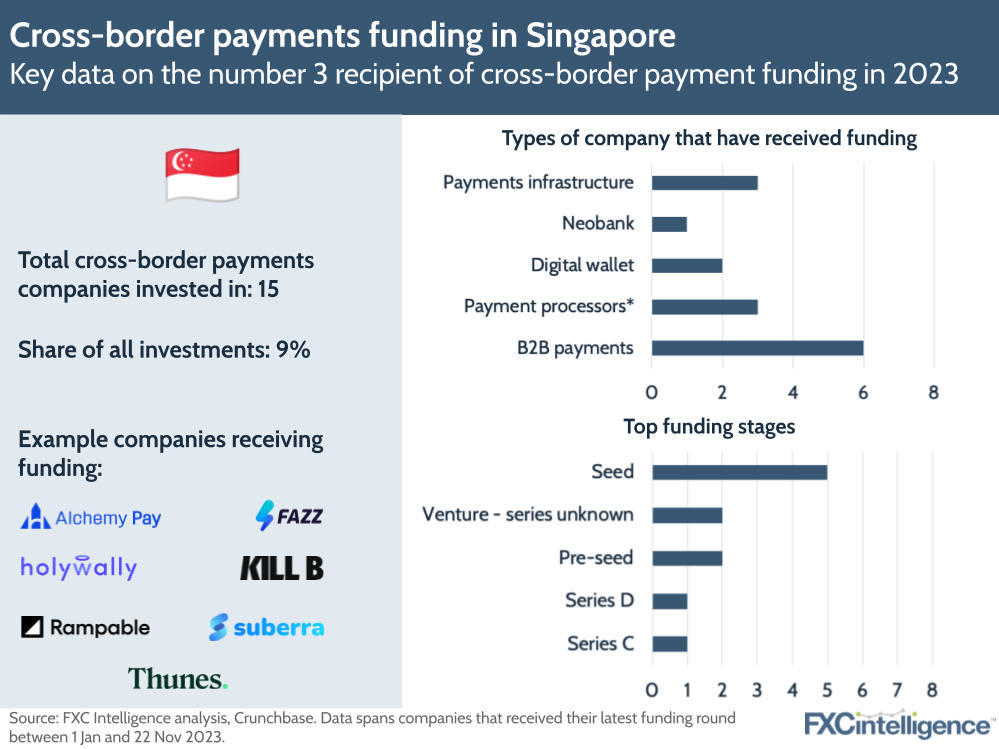
Nigeria
Nigeria continues to be a focal point for both startups and established companies in the cross-border payments space, although the majority of its investments were in companies at the Pre-Seed and Seed stages. Notably, none of the Nigerian companies in the list appear to have a significant focus on crypto.
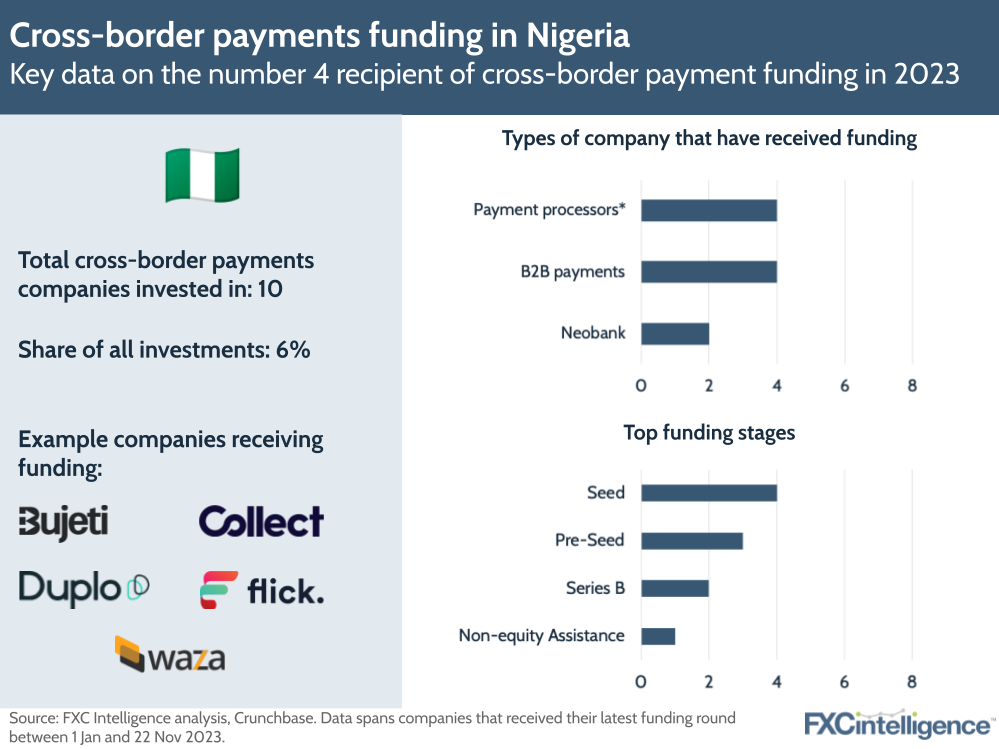
Canada
Despite Canada being the number five recipient for cross-border payment funding on our list, just 4% of companies had their headquarters there, indicating both the dominance of the UK and the US, as well as how spread out startup funding has been this year, given that 50 countries were represented.
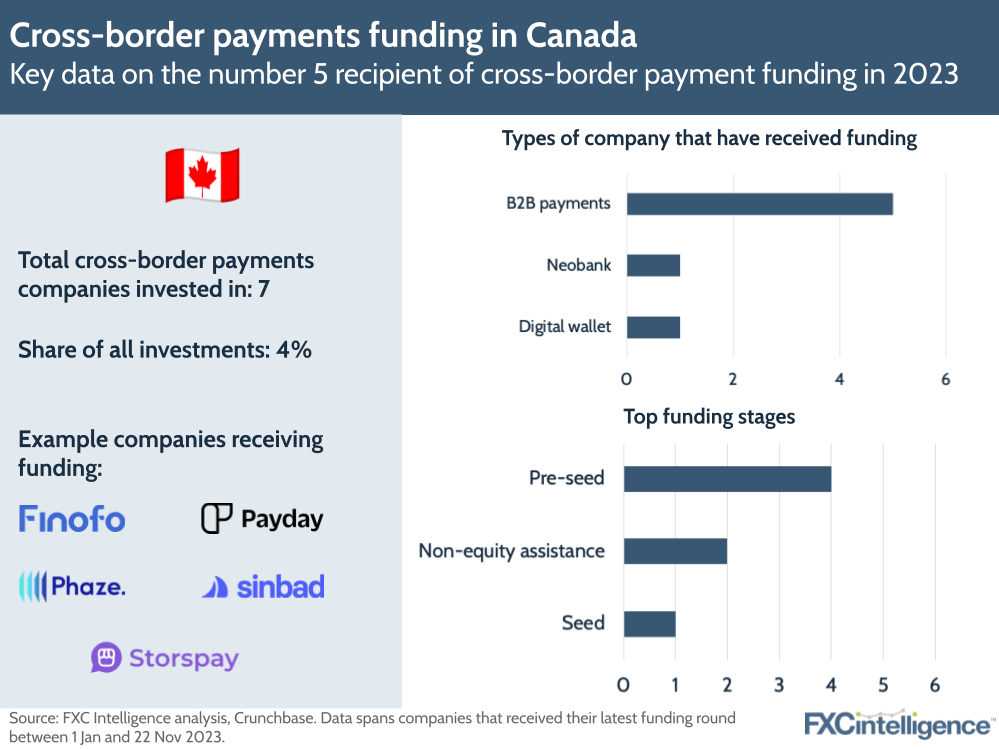
Who is investing in cross-border payments startups?
While there were over 400 different investors who took stakes in cross-border payment startups this year, a small number were prolific in the space.
The graphic below shows the companies that have made the highest number of investments in cross-border payments companies for this year. Note that this data spans all rounds for companies on the list and only includes publicly stated investors.
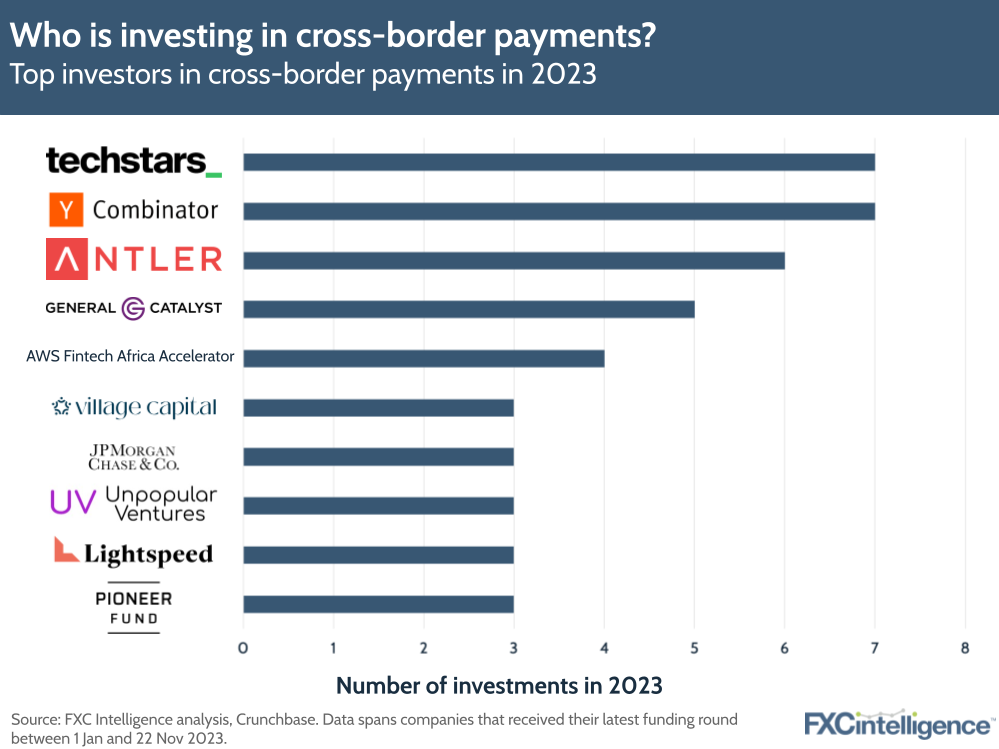
Investors in the space this year can for the most part be placed into one of four groups. These are startup-focused accelerators, such as AWS Global Fintech Accelerator and Y Combinator; banks, such as J.P. Morgan, Bank of America and Crédit Agricole; venture capital businesses; and other established payments companies such as Mastercard and Visa.
Among the most prolific investors, companies have typically spread their investments geographically rather than investing only in companies from a single country. Y Combinator, for example, has played a role in funding for companies from the US, Nigeria, Singapore and the Democratic Republic of Congo.
Trends in cross-border payments startups
This year, B2B payments has been a key focus for investors in cross-border payments companies. This reflects the still significant and broad opportunity in this space, as well as the relative lack of maturity in this market, compared to consumer money transfers.
While a minority, crypto continues to be present in around a quarter of companies receiving funding, and as regulations shift we may see more interest in this area. However, while other categories of payment companies appear globally, most crypto activity is focused on the US, so it will be worth watching to see if other regions see an increase in the technology’s use for cross-border payments in the future.
Finally, while the US continues to be the biggest hub for investable cross-border payments companies, a wide number of HQ locations worldwide highlights the growing global potential of cross-border payments.



